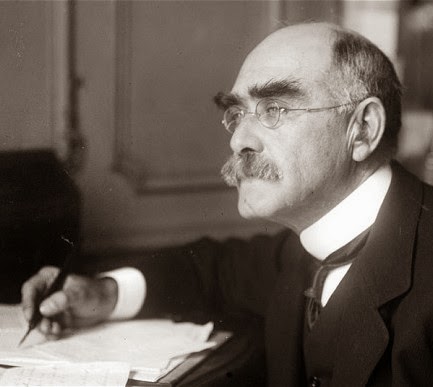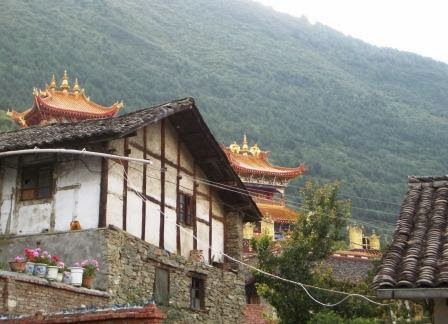Part X
“I
would like to try to deal with some of the more intimate and personal aspects
of travel. They may be trivial or absurd, but one must remember that in a few
years, most of our existing methods of transport, together with the physical
and mental emotions that accompany them, will be profoundly changed. The time
is near when men will receive their normal impressions of a new country
suddenly and in plan, not slowly and in perspective; when the most extreme
distances will be brought within the compass of one week’s – one hundred and
sixty-eight hours’ – travel; when the word ‘inaccessible’ as applied to any
given spot on the surface of the globe will cease to have any meaning.”
These words were spoken a little
over a hundred years ago by Rudyard Kipling (1865-1936) in an address to the
Royal Geographical Society in London. The exact date was the evening of
February 17th 1914.[1]
When reading travel accounts from this era I’m often struck by how remarkably
forward looking they are; something which is notably in contrast to similar
travel accounts published in our own time, which often strike me as being
rather more nostalgic. Perhaps it was a characteristic of the age of Western
imperialism? Notions of modernity infusing a sense of purpose and a sense of
faith in human progress. Boundaries were busily being pushed back. Frontiers
were falling. The project of globalisation was proceeding apace. And now, in
our own era, when that project has perhaps faltered or reached some sort of
equilibrium, faced with newly dawning uncertainties, what else can we do but
look back? [2]
Commenting on Kipling’s talk that
evening, Lord Bryce (1838-1922) – who was asked by Lord Curzon (1859-1929), the
President of the RGS, to express the meeting’s thanks to Kipling – he continued
the observation quoted above with which Kipling opened his talk: “If any of you are inclined to envy the men
and women of the future who will be able, in the course of an afternoon to
reach the United States, and South Africa to-morrow morning, and to wish that
you had been born in those days, let us comfort ourselves with the thoughts
that at those heights which the airships will traverse, there will be no
colours of landscape to enjoy, for colour fades out of things when you pass
over them at a height of 5000 or 6000 feet. Neither will any scents reach the
future high-level travellers. So let us come back to the old conclusion that we
may be well content with the world in which we live, even if it be not the best
of all possible worlds.”
One can’t help wondering what Lord
Bryce would have made of the realities of travelling long-haul economy class at
35,000 or 36,000 feet (!) today – with the blinds all pulled firmly down in
accordance with the cabin staffs’ instructions, and everyone with headphones on,
plugged into their TV sets and tucking into their in-flight meals, whilst
assailed by the stifling dryness and the occasional odd aromas circulating in
the recycled air of the closed cabin (Kipling’s talk had made a point of
emphasising the evocative nature of smell as a distinctly remembered
characteristic of travel). Perhaps this shows that some people a hundred years
ago had a clearer vision of ‘human progress’ than others! I don’t suppose Lord
Bryce would have been a fan of modern air travel – for all its gruelling convenience,
how many of us in our hectic and evermore time-pressed lives can conceive of
the same journey taken by steamer over weeks through both choppy seas and fine
weather? How does our experiences of turbulence compare to a howling gale on the
water? Or the spun body-clock of jetlag to the forced idleness of days spent in
a cabin or strolling the promenade deck with nothing but a desolate expanse of
water to meditate upon?
Travel is always an experience.
Often travel is defined by its modes of transport as much as its duration, and by
our company too – all these elements essentially combine. In the early 1990s I
went on two separate student exchange trips to the newly re-unified Germany.
For the first of these we travelled out from the UK overland by bus, for the
second we flew. On the first we had a two day trip before we reached our
destination in which to get to know one another better than we previously had
in the normal day-to-day routines of our school life, and consequently it
induced a tight knit camaraderie which transformed our subsequent stay in
Germany. On the second exchange trip a few years later, which was made with a
different group of students at a different school, we were very much flung
instantly into our new situation overseas in a much more immediate and isolated
sense as the flight lasted less than two hours. An hour in the departure hall
wasn’t enough time to make us feel like the solid intrepid band which had been
forged and united by the previous bus and ferry ride across the Channel and the
autobahn to Germany. In a similar way
my trip to 康定 Kangding (དར་རྩེ་མདོ། Dartsendo) was defined by the effort
required to reach the town.
It took only a few hours to fly
from Shanghai to Chengdu, but (on average) an eight hour bus ride out to
Kangding and the same back again – a journey which a hundred years ago would
have been made over a number of days and mostly on foot. Reaching Kangding
really felt like reaching somewhere partly because of the effort required and
partly because it is still quite an ‘out of the way’ sort of place, not quite
altogether off the beaten track but still comparatively speaking fairly remote.
Here though, I was travelling
alone. There were only a handful of other Westerners staying or living in
Kangding. Most of the travellers (as we were all independent travellers rather than
package tourists) were holed up at one of either two hostels, and a lot of
these seemed to be just passing through or taking a couple of days’ break to
catch up with laundry and internet. I spent a lot of time wandering around the
town, with a sheaf of old photos printed out from my computer, trying to match
old views to the present, seeking to orientate myself and get my bearings,
piecing together an old version of Kangding which had long since been
transformed, buried, or disappeared. Every now and then I’d find a former trace
of that past place, and as such a little more of the history which I’d either
heard or read about from family, or books or archives would fall into place.
But reflecting on this now, it wasn’t so much the cliché of bringing history to life – it was more
like a process of conjectural surveying and factual mapping. In my mind I was
constantly pegging reference points and trying as best as I could to connect
them together to form a clearer understanding. Continually stopping to remind
myself that it was easy to make assumptions and that one should always qualify
oneself with the thought that an idea or link could later prove incorrect or
wrong.
Trying to place the old French
Catholic Church was a case in point. Having climbed a flank of one of the
hillsides overlooking the town to a precarious vantage point I managed to
convince myself that the location of the old church might well have been on the
site of the present one (which on the face of things seemed logical enough) –
yet later on it became apparent from carefully scrutinising another
photographic source that the geography of that particular theory was probably
all wrong; as such, seen from a different angle, the old church was more likely
to have been situated on the other side of the river and further downstream
(perhaps near where the modern town square or piazza is presently located?). As
with a lot of these types of thing, it’s probably hard to ever be certain.
Something I’ve yet to come across
is any old, officially printed or even roughly sketched maps of the town’s
former layout. But that’s the point of research, you never really give up – you
keep looking, and you keep your mind open to revising your findings in the
light of new discoveries. As with my last stroll along the Lu Ho Valley,
there’s always the lure of that next bend in the road or rise on the horizon,
tempting you ever forward, wondering what you might find just around the
corner. The difficulty and perhaps the greatest sadness is deciding when to
stop and draw a line. Maybe you’ll decide to keep travelling forever, or maybe
others travelling with you or after you will take your journey further – but in
the end, that is something which only time will tell.
Such journeys aren’t all about the
past though. Our notions of history say as much about the present as they do
about the reality of the past. It’s a fascinating angle to explore the here and
now as much as it is to seek out the past. Chatting to Mr and Mrs Lao in their
front room; or being welcomed in by Tibetan monks eager to practice their
English with an interloping foreigner; or being hijacked and lead on a happy,
whirlwind tour of a lamasery by some local children – for whom the lack of a
shared language didn’t seem to be any sort of a barrier; or, similarly, being
invited to take shelter from the mountain rain in a farmer’s house and managing
to use my battered old Japanese/Chinese/English vocab’ book to communicate with
him and his family over copious cups of hot tea and warm natured smiles. All of
these experiences combined to make my own trip to Kangding a memorable and
personally rewarding one. I found much more than I’d dared to expect travelling
to Kangding, and, as such, I hope it will in time prove to be but the first of
several – perhaps longer – trips yet to the town and the regions beyond.
This
is the last in my series of posts on my 2010 research trip to Kangding
(Dartsendo). I will occasionally write other posts related to my research, upon
the lives of Rinchen Lhamo and Louis Magrath King, as well as the broader topic
of my PhD which will be focussing on Western travellers in East Tibet in the
early 20th century and the theme of ‘science and imperialism.’ These
will all be listed and linked under the ‘research’ tab at the top of this blog.
If anyone would like to post comments on the blog or contact me directly to discuss these
topics or my research I’d be most grateful to hear from you.
[1]
See: The Geographical Journal, Vol.
XLIII, No. 4 (April, 1914), pp. 365-378
[2] I
think there’s the germ of an idea for a paper waiting to be written here!


















No comments:
Post a Comment
Comments do not appear immediately as they are read & reviewed to prevent spam.